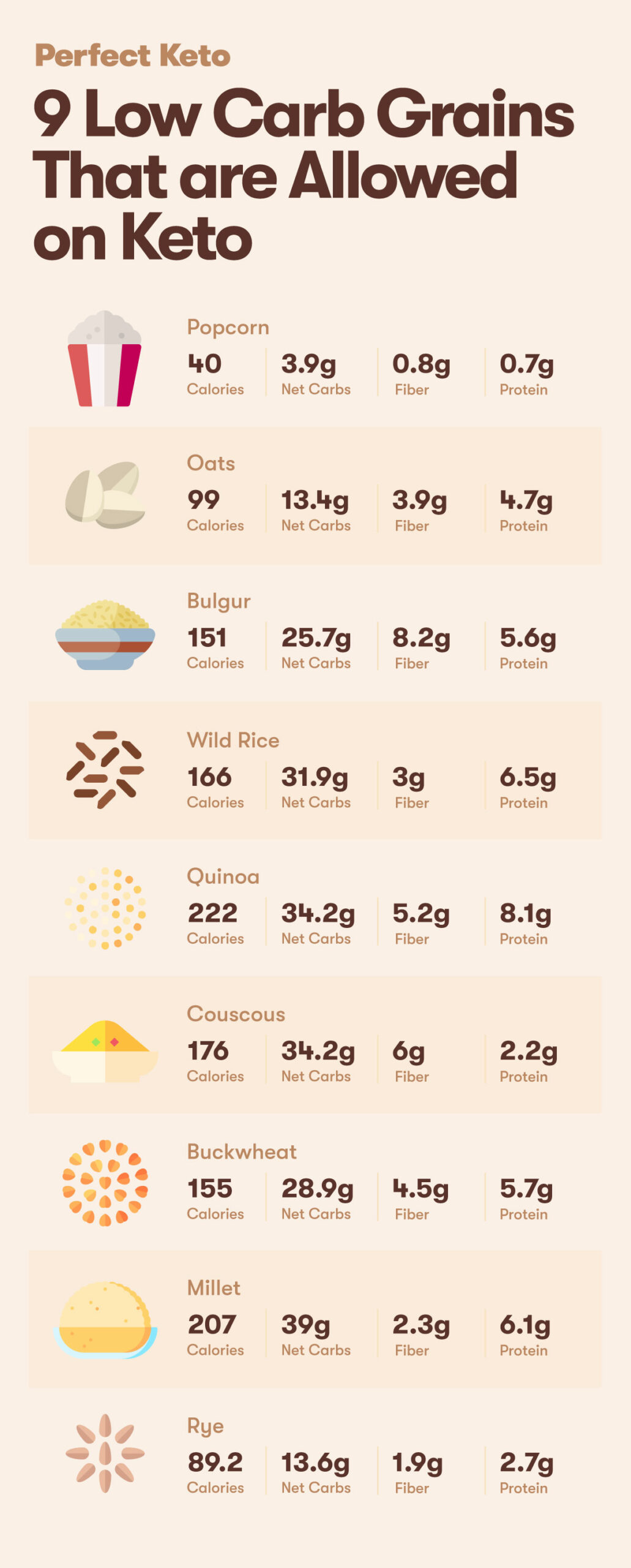Contrary to common belief, incorporating some grains into a ketogenic diet is possible. While the keto diet is characterized by low-carb and high-fat intake, not all grains are off the table. Low-carb grains, in moderate amounts, can fit into a ketogenic diet while still keeping your body in ketosis. In this article, we’ll delve into the nutritional profiles of these keto-friendly grains, their potential health benefits, and the ones you should consume sparingly or avoid for optimal health.
Which Grains are Low in Carbs?
Before we dive in, here’s a quick look at how many the best low-carb grains and how many carbs they have per serving:
- Popcorn – 3.9 grams of net carbs per cup
- Oats – 13.4 grams of net carbs per cup
- Bulgur – 25.7 grams of net carbs per cup
- Wild Rice – 31.9 grams of net carbs per cup
- Quinoa – 34.2 grams of net carbs per cup
- Couscous – 34.2 grams of net carbs per cup
- Buckwheat – 28.9 grams of net carbs per cup
- Millet – 39 grams of net carbs per cup
- Rye – 13.6 grams of net carbs per slice of rye bread
9 Low Carb Grains That are Allowed on Keto
Below is a list of some of the best grains you can add to your ketogenic diet:
1. Popcorn
Popcorn is a beloved snack for many of us. It’s not only fun to eat but also a nutritious whole grain.
Let’s break down what you get in a cup of oil-popped popcorn (*):
- Calories: 40
- Net Carbs: 3.9 grams
- Fiber: 0.8 grams
- Protein: 0.7 grams
Plain popcorn also comes with vitamins and minerals. These include B-vitamins and magnesium, and a little bit of iron. Remember, this is for plain popcorn. If you add flavors like sweet, salty, or caramel, it changes the nutritional value and sometimes increases the carbs.
Popcorn is great, but it’s easy to eat too much. It’s therefore important to watch your portions. If possible, consider air-popped popcorn as it is even lower in calories. Additionally, making your popcorn at home lets you control how much you eat and what goes into it.
2. Oats
Oats are a breakfast classic enjoyed by many cultures worldwide. This is mostly due to their versatility and rich nutritional composition.
Here’s the nutritional breakdown for a cup of cooked oats (*):
- Calories: 99
- Net Carbs: 13.4 grams
- Fiber: 3.9 grams
- Protein: 4.7 grams
One remarkable component of oats is beta-glucans, a type of soluble fiber known for its heart health benefits, including reducing cholesterol levels (*). Additionally, oats are rich in essential micronutrients, with good amounts of magnesium, phosphorus, and thiamine, among others.
Oats aren’t just for porridge; they can also be a key ingredient in baked goods such as bread and cookies. While mostly eaten sweet, they work just as well in savory dishes, like oatmeal risotto or savory oat pancakes. When choosing oats, opt for steel-cut or rolled varieties over instant ones. These less processed forms retain more of their natural fiber content and provide a slower, more steady release of energy, making them a healthier option.
3. Bulgur
Bulgur is a whole grain derived from cracked wheat berries. This Middle Eastern staple offers a nutty flavor and a satisfying chewy texture that can complement various dishes.
A cup of cooked bulgur contains (*):
- Calories: 151
- Net Carbs: 25.7 grams
- Fiber: 8.2 grams
- Protein: 5.6 grams
Bulgur also contains substantial amounts of magnesium, and iron. It’s a wonderful source of vitamin B6 which is essential for maintaining red blood cells.
You can use bulgur in a variety of dishes. A popular one is ‘Tabbouleh’, a refreshing salad made with bulgur, parsley, tomatoes, and a lemony dressing. To make it, simply soak bulgur in boiling water until tender, drain, and mix with chopped fresh parsley, tomatoes, a squeeze of lemon juice, olive oil, and some salt.
4. Wild Rice
Wild rice, despite its name, isn’t technically rice. It’s a type of grass seed from North America, naturally richer in nutrients compared to white rice.
A cup of cooked wild rice provides (*):
- Calories: 166
- Net Carbs: 31.9 grams
- Fiber: 3 grams
- Protein: 6.5 grams
This grain is a great source of iron and magnesium. Additionally, it offers B6 and is rich in antioxidants and phytonutrients, which contribute to overall health and disease prevention.
Cooking wild rice differs from white rice as it requires a longer cooking time and more water. Generally, a ratio of 1:3 (rice to water) works well, and it should simmer for about 45-50 minutes. The end result should be a soft grain with a delightful nutty flavor and a chewy texture.
5. Quinoa
Quinoa, while often grouped with grains, is actually a seed from a plant related to spinach and beets. Its claim to fame is its high-quality protein content, containing all nine essential amino acids, which is rare in plant foods.
A cup of cooked quinoa offers (*):
- Calories: 222
- Net Carbs: 34.2 grams
- Fiber: 5.2 grams
- Protein: 8.1 grams
Some of the micronutrients in quinoa include copper, magnesium, phosphorus, manganese, and vitamins E, B6, and folate. It also has some iron and zinc.
Quinoa is as versatile as it is nutritious. For a sweet dish, try it as a breakfast cereal with almond milk, berries, and a touch of honey. For savory options, it’s best rinsed, then cooked in water or broth using a 1:2 ratio for about 15 minutes. It works well in salads, stir-fries, or as a base for veggie bowls.
6. Couscous
Couscous, a staple in North African cuisine, may not be as nutrient-dense as other whole grains, but it offers the advantage of being lower in carbs. Its delicate, slightly nutty flavor and fluffy texture make it a versatile food.
Here are the macros for a cup of cooked couscous (*):
- Calories: 176
- Net Carbs: 34.2 grams
- Fiber: 6 grams
- Protein: 2.2 grams
Couscous, while not a good source of vitamins and minerals, is one of the best sources of selenium providing about 60% of your daily needs.
It can be an alternative to grains like rice or quinoa in various dishes. Think salads, stews, or as a side dish. For a quick recipe, toss cooked couscous with olive oil, lemon juice, diced veggies, and your favorite herbs and you have yourself a healthy refreshing salad.
7. Buckwheat
Buckwheat, often used in Japanese soba noodles, isn’t technically a grain but a seed. Similar to quinoa, It’s known for its high-quality protein, as it provides all essential amino acids.
A cup of cooked buckwheat grains contains (*):
- Calories: 155
- Net Carbs: 28.9 grams
- Fiber: 4.5 grams
- Protein: 5.7 grams
You can cook buckwheat in a variety of dishes, like salads, stews, or as a stand-alone side. It’s also ground into flour, which can be used in pancakes, bread, and pastries. However, be mindful of overly processed forms, as they can lose some nutrients and are often higher in carbs.
8. Millet
Millet, a small but mighty grain, often gets overlooked. While it’s true that it has a higher net carb count due to its lower fiber content, millet still packs a nutritional punch.
Here’s the breakdown for a cup of cooked millet (*):
- Calories: 207
- Net Carbs: 39 grams
- Fiber: 2.3 grams
- Protein: 6.1 grams
In terms of micronutrients, millet offers three main ones which are iron, magnesium, and vitamin B6.
Millet can be a delightful addition to your diet with its light, slightly nutty flavor and fluffy texture. It works well as a side dish, similar to rice or quinoa. You can also use it in salads, stir-fries, or as a base in grain bowls.
9. Rye
Rye, a close relative of wheat, is mostly known for its use in rye bread. It is packed with nutrients, particularly rich in dietary fiber, which aids in digestion and keeps you feeling full.
One regular slice of rye bread (32 grams) contains:
- Calories: 89.2
- Net Carbs: 13.6 grams
- Fiber: 1.9 grams
- Protein: 2.7 grams
Rye also provides some iron and magnesium. Its high antioxidant content further enhances its nutritional profile.
While rye is commonly used to make a hearty, dense bread, it also works in many other dishes. Whole rye grains can be cooked and used in salads, baked snacks, soups, or as a side dish. Rye flakes are available in some areas and can be used in porridge or granola.

Which Grains Should I Avoid on Keto?
Now that you know which grains you can have on keto, below is a list of those you should stay clear of:
- Instant Oats – Instant oats are pre-cooked, dried, and then rolled and pressed thinner than rolled oats. This makes them cook quickly, but it also strips away some fiber, leading to a higher net carb count.
- Sugary Breakfast Cereals – Sugary breakfast cereals often start with refined grains that are heavily processed, stripping away beneficial nutrients such as fiber, vitamins, and minerals. The result is a breakfast option that, while quick and easy, can lead to energy crashes and hunger shortly after eating.
- Processed Corn Products – Processed corn products, like cornmeal, corn flour, and corn syrup, undergo processing that strips away nutritious parts of the corn, leaving products that are low in fiber and other nutrients.
- Flavored Popcorn – Flavored popcorn often contains unhealthy additives. Caramel popcorn is especially not keto-friendly as it is typically coated in a sugary syrup. Butter and cheese popcorn, while technically keto-friendly, often contain high levels of sodium and trans fats.
- White Bread – White bread is made from refined wheat flour, which undergoes a process that removes the nutrient-rich bran and germ, leaving only the endosperm. The resulting high glycemic index means that white bread can lead to rapid spikes in blood sugar and insulin levels.
The Bottom Line
While grains can be a source of essential nutrients, it’s crucial to make informed choices about which ones to include in your diet. Opt for whole, less-processed grains for maximum benefits, and remember to practice portion control. You’ll likely need to keep most of these grains to a 1 cup maximum if you are on keto but you may be able to indulge a little bit more on a low-carb diet. Remember to balance your grain intake with a variety of other nutritious foods like nuts and vegetables for a well-rounded, healthy diet.
